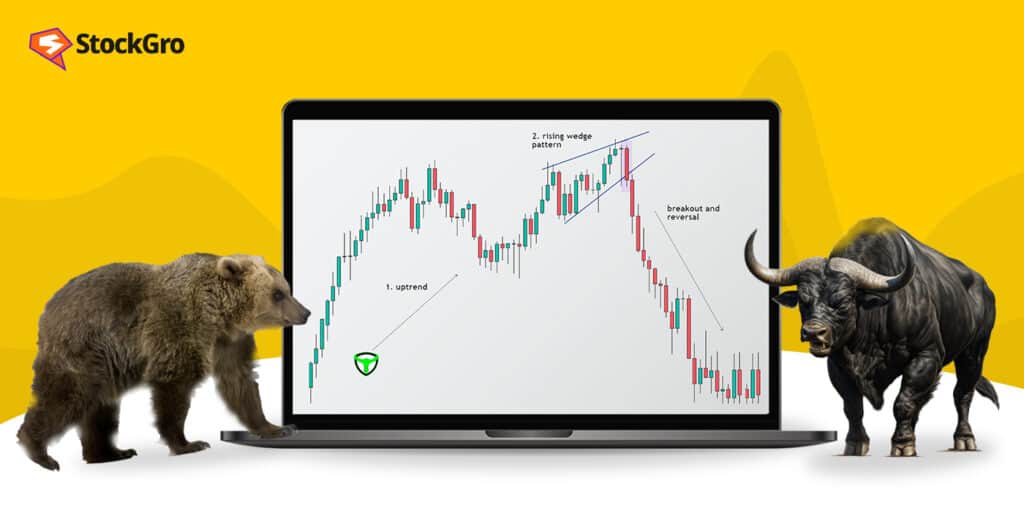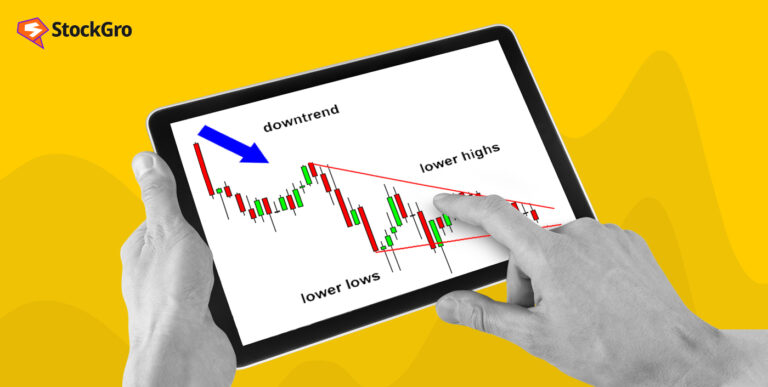
Today, we dive deep into an aspect of technical analysis – the rising wedge pattern. At first, these patterns might look like simple doodles on a chart, but they hold much more significance. Here’s a simple guide to help you understand the ins and outs of the rising wedge pattern and its relevance in the stock market.
The basics of wedge patterns
Before diving into the specifics of the rising wedge pattern, let’s explore the basics of wedge patterns. A wedge pattern is a price movement in a chart where the lines converge or diverge over time.
Picture two lines coming closer or moving apart on a graph. These patterns provide crucial hints about upcoming price moves. They’re like silent storytellers, revealing secrets of the stock market world.
You may also like: Inverted hammer vs shooting star: Which candlestick pattern rules the charts?
Spotting the rising wedge chart pattern
The rising wedge chart pattern is a specific type of wedge pattern. Unlike other chart patterns, the lines in a rising wedge are inclined upward but converge as they rise. So, what does this mean? The price movements are getting closer together, even as they ascend.
The rising wedge has one distinct characteristic and that is, it marks a possible turning point in the price trend. This formation usually occurs in an uptrend, but rather than indicating more upside movement, it suggests bearishness instead.
As the price rises and the range narrows, it shows that buyers are losing their strength while sellers gradually start stepping in. This struggle between buyers and sellers begins to increase more and more as the price comes close to the high peak of the wedge respectively.
Traders usually look for a break below the lower trendline of the wedge as a confirmation of the pattern’s completion. Once the price breaks downward, it often results in a sharp decline, as the market sentiment flips from bullish to bearish. Volume can also play a role in confirming this pattern. A declining volume during the formation of the wedge, followed by a surge when the price breaks down, can validate the pattern and increase the chances of a strong move.
Identifying a rising wedge early allows traders to plan their strategies, either by tightening stop losses or preparing for short positions. It’s a useful tool in technical analysis, especially when timing market reversals. Learn to identify and interpret share market chart patterns and how technical chart patterns can signal profitable trading opportunities.
Features of the rising wedge pattern
- Trending upward – This pattern shows that prices are trending upward, but this isn’t necessarily a sign of continued upward momentum.
- Convergence – The lines depicting the highs and lows are getting closer together.
- Volume decrease – Often, but not always, volume decreases as the wedge forms. This means fewer stocks are being bought or sold, and it’s a cue for traders to be alert.
Bearish undertones in a rising pattern
Don’t be deceived by the name – a rising wedge is often bearish. This is intriguing, isn’t it? You’d think rising would indicate a bullish market, but things aren’t always as straightforward in the world of stock charts. Bearish engulfing is a reversal pattern that signals a bearish return in a bullish market.
The bearish wedge pattern indicates that even though the trend is upward, it might reverse soon. In simpler terms, the price could fall in the near future. This is a sign for investors to be cautious and maybe even consider selling their stocks.
Also Read: Understanding double bottom pattern
Predicting the rising wedge pattern target
Every investor dreams of predicting the stock market. While no one can predict the future with absolute certainty, patterns like the rising wedge provide strong clues.
Once the price breaks below the lower line of the wedge, it often falls to a level that’s roughly equal to the height of the wedge at its beginning. This prediction isn’t foolproof, but it’s a tool many traders find invaluable.
Key features of the rising wedge pattern
| Feature | Description |
| Direction | Upward |
| Expected move after breakout | Downward |
| Common mood | Bearish, even though it’s a rising pattern |
| Price target prediction | Roughly equal to the height of the wedge at the start |
How to capitalise on the rising wedge pattern
Stepping into the world of stock trading armed with the knowledge of patterns is like having a map in a complex maze. The rising wedge pattern, in particular, offers cues to understand the market’s next potential move. Here’s how you can use this pattern to your advantage.
- Keeping an eye on the volume
One of the subtle hints that often accompanies the formation of a rising wedge pattern is the decrease in trading volume. As the pattern matures, fewer stocks get traded.
This fall is like the calm before a storm, signalling potential change. Regularly monitoring the volume can give you a head start in anticipating a price drop.
Also Read: Insights into market trends and reversals using Inverted Hammer
- Setting up stop-loss orders
A wise move when you suspect the formation of a bearish wedge pattern is to set up a stop-loss order. This order automatically sells a stock when it reaches a certain price, ensuring you don’t face hefty losses if prices plummet.
- Being patient
Even if you spot a rising wedge pattern forming, it doesn’t mean action is required immediately. It’s crucial to wait for the pattern to complete its formation. Acting too hastily can lead to missed opportunities or, worse, losses.
- Diversifying your portfolio
While the rising wedge pattern is a potent tool, it’s always wise not to put all your eggs in one basket. Diversification, or spreading your investments across various assets, can cushion you against potential losses.
- Continuous learning and adaptability
The financial world is in constant flux. New patterns emerge, and old ones evolve. Stay updated by attending webinars, reading relevant books, and engaging with trading communities. The rising wedge pattern is just one of the myriad patterns out there. The more you know, the better equipped you’ll be.
Strengths and Weaknesses of Rising Wedge Pattern
Here are its strengths and weaknesses:
Strengths:
- Reversal Indicator: While this pattern is usually formed in an uptrend, it resembles a reversal to the downside. Therefore, it comes in handy to all traders who wish to take advantage of shifting market dynamics.
- Volume Confirmation: As the pattern develops, a decrease in trading volume often accompanies the rising price, indicating weakening buyer momentum. This divergence can enhance the reliability of the signal.
- Predictive Nature: The pattern provides clear entry and exit points for traders. Once the price breaks below the lower trend line, it often leads to a significant price drop, allowing for effective trade execution.
Weaknesses:
- False Breakouts: Like many technical patterns, the rising wedge can produce false signals. Prices may break out in the opposite direction, leading to potential losses for traders.
- Limited Longevity: The rising wedge is typically a short-term pattern, which may not be suitable for long-term trading strategies. Traders need to be vigilant and ready to act quickly.
- Subjectivity in Identification: Identifying a rising wedge can be subjective, as different traders may interpret chart patterns differently, leading to inconsistent trading decisions.
Trading on Rising Wedge Pattern
The rising wedge is a chart pattern in technical analysis that consists of two upward-sloping trendlines with converging characteristics. It signals a potential reversal in an uptrend, making it a crucial tool for traders.
As the price rises, the upper trendline ascends at a steeper angle than the lower trendline, indicating decreasing momentum despite increasing prices.
When trading a rising wedge, traders must wait for the following signs:
- Formation: Ensure that the wedge is forming after a pronounced uptrend, confirming that it could be a bearish reversal signal.
- Volume Analysis: Volume typically decreases as the wedge progresses. A significant increase in volume upon the breakout can validate the pattern.
- Breakout Point: The critical breakout occurs when the price closes below the lower trendline. Traders often enter short positions at this point, targeting a profit objective based on the wedge’s height.
- Stop-Loss Placement: To manage risk, it’s advisable to place a stop-loss order above the last swing high within the wedge.
Confirmation: Look for additional confirmation through other technical indicators, like the Relative Strength Index (RSI), which may show divergence, suggesting weakening buying pressure.
Conclusion – The power of patterns
Chart patterns like the rising wedge pattern provide a fascinating glimpse into the intricacies of stock trading. They serve as silent indicators, whispering about potential price movements.
By understanding and harnessing the power of these patterns, traders and investors can navigate the ever-turbulent waters of the financial world with greater confidence.
Remember, in trading, as in life, knowledge is not just power; it’s profit. So, keep learning, stay curious, and may your trades always be informed and fruitful.

